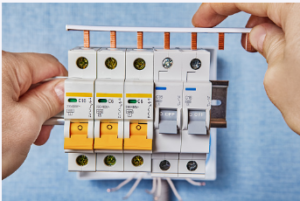Your switchboard is the central hub of your entire electrical distribution. It enables electricity to flow through circuits and is essential for safety in your home.
Older switchboards are more prone to hazards, so Switchboard upgrades Adelaide is always a good idea. It also ensures your house is compliant with Australian Electrical Standards.
 Fuses Blowing or Melting
Fuses Blowing or Melting
If you’re completing a switchboard upgrade, one of the most common problems that can arise is fuses blowing or melting. It can signal that your circuit has been overloaded and needs rewiring.
Fuses are a crucial part of electrical safety systems, as they can interrupt the current in a circuit if it gets too hot or short courses. They can also be tripped by magnetic fields or external devices called protective relays. They are available in various types and sizes to meet different demands.
They are rated for maximum current and can be designed to blow fast, slow, or anywhere to interrupt a particular circuit. Some fuses are rated for low voltage, and some for high voltage. Some are resettable (PPTC) fuses, which use a thermoplastic conductive element to impede the circuit in the event of an overcurrent condition by increasing device resistance.
Other fuses can have high-power ratings and can interrupt several kiloamperes of current. These are commonly used in industrial applications such as transformer stations, main distribution boards and building junction boxes.
These fuses are generally larger than screw-type fuses and have ferrule cap or blade contacts. They are also known as meter fuses and are rated for up to 120 kA of short-circuit current.
The molten metal inside a fuse can cause severe injury or damage to the surrounding environment, so if it’s blowing or melting, you must act quickly. To determine if your fuse is blown, look for the glass container and see if there’s a gap in the wire or a metallic smear inside.
You can also examine the fuse’s base to see its amperage rating and replace it with a new one with the same wattage. The amperage is usually printed on the fuse, stamped into the fuse base or moulded into the glass container.
Circuit Breakers Tripping
If your circuit breakers keep tripping, looking closely at the issue is crucial. It can save you from a potential electrical disaster that could be very costly and potentially dangerous.
The most common cause of frequent power tripping is an overloaded circuit. It is typically caused by running appliances on a single course that is not rated for the electricity consumed. For example, this can happen when using window unit air conditioners, microwaves, portable heaters or vacuum cleaners simultaneously.
A faulty appliance, damaged wiring or poor installation can cause a short circuit. It is a grave concern, so having any wiring issues checked by an expert is essential.
You can determine which circuit the breaker belongs to by checking all the connected outlets and switches. It will give you a better idea of which appliance is the culprit and can help you troubleshoot.
Flickering Lights
Switchboard upgrades Adelaide can be expensive, but they are necessary for your family’s safety. An overloaded home with electrical devices and appliances can lead to dangerous situations, such as flickering lights or fires. Therefore, upgrading your switchboard as soon as possible is crucial to prevent these problems.
Flickering lights can be caused by various issues, from faulty bulbs to loose connections in your wiring. However, they can also be a sign of a much more severe problem that needs to be addressed immediately.
One of the simplest things you can do to troubleshoot this problem is to check the light bulb and ensure it is screwed in correctly. If this does not solve the flickering, it is likely due to a loose connection in your wiring system, such as the circuit breaker, switchboard or meter box.
Another thing you can do is to try replacing the bulb with a different type, such as an LED or a non-LED dimmer light bulb. It can fix the flickering problem for good.
If the problem is not fixed, you need to call an electrician as it could be a more complicated problem, such as faulty wiring or outdated switches. An electrician can look into the situation more thoroughly and recommend the best solution for your home.
Some people ignore flickering lights until they get worse, but this is never wise. As they are a common sign of a severe electrical problem, all homeowners should take them seriously.